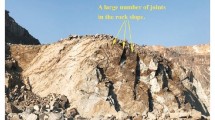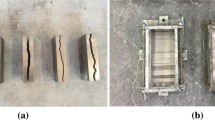Abstract
In this article, the shear behavior of discontinuities caused by bedding planes of weakness between two different rock types with high strength difference is investigated. The effect of roughness and compressive strength of joint wall in such discontinuities are studied. The designed profiles consist of two regular and three irregular artificial joints molded by three types of plaster mortars with different uniaxial compressive strengths. Firstly, it is demonstrated that the shear behavior of discontinuities with different joint wall compressive strengths (JCS) is different from rock joints with identical wall compressive strengths by showing that Barton’s empirical criterion is not appropriate for the former discontinuities. After that, some correlation equations are proposed between the joint roughness coefficient (JRC) parameter and some surface statistical/fractal parameters, and the normal stress range of Barton’s strength criterion is also modified to be used for such discontinuities. Then, a new empirical criterion is proposed for these discontinuities in such a way that a rational function is used instead of JRC log10(JCS/σ n) as i 0(σ c/σ n)a/[b + (σ c/σ n)a] by satisfying the peak dilation angle boundary conditions under zero and very high normal stress (physical infinite normal stress causing zero peak dilation angle). The proposed criterion has three surface parameters: i 0, a, and b. The reason for separation of i 0 from JRC is indicated and the method of its calculation is mentioned based on the literature. The two remaining coefficients (a and b) are discussed in detail and it is shown that a shows a power-law relationship with b, introducing the coefficient c through b = c a. Then, it is expressed that a is directly related to discontinuity surface topography. Finally, it is shown that the coefficient c has higher values in irregular profiles in comparison with regular profiles and is dominated by intensity of peak dilation angle reduction (majorly related to the surface irregularity and minorly related to roughness). The coefficient c is to be determined by performing regression analysis on experimental data.


















Similar content being viewed by others
References
Aydan O, Shimizu Y, Kawamoto T (1996) The anisotropic of surface morphology characteristics of rock discontinuities. Rock Mech Rock Eng 29(1):47–59
Barla G, Forlati F, Zaninetti A (1985) Shear behavior of filled discontinuities. Fundamentals of rock joints. In: Proceedings of international symposium on fundamentals rock joints. Bjorkliden, Centek, pp 163–172
Barton N (1973) Review of a new shear strength criterion for rock joints. Eng Geol 7:287–332
Barton NR, Choubey V (1977) The shear strength of rock joints in theory and practice. Rock Mech 10:1–54
Berry MV, Lewis ZV (1980) On the Weierstrass–Mandelbrot fractal function. In: Proceedings of the Royal Society of London, Series A370, pp 459–484
Brown SR, Scholz CH (1985) Broad band width study of the topography of natural rock surfaces. J Geophys Res 90:12575–12582
Den Outer A, Kaashoek JF, Hack HRGK (1995) Difficulties with using continuous fractal theory for discontinuity surfaces. Int J Rock Mech Min Sci 32:3–10
Fairhurst C (1964) On the validity of the Brazilian test for brittle materials. Int J Rock Mech Min Sci Geomech Abstr 1:535–546
Feder J (1988) Fractals. Plenum, New York
Grasselli G, Egger P (2003) Constitutive law for the shear strength of rock joints based on three-dimensional surface parameters. Int J Rock Mech Min Sci 40:25–40
Grasselli G, Wirth J, Egger P (2002) Quantitative three-dimensional description of a rough surface and parameter evolution with shearing. Int J Rock Mech Min Sci 39:789–800
Haberfield CM, Johnston IW (1994) A mechanistically-based model for rough rock joint. Int J Rock Mech Min Sci Geomech Abstr 31:279–292
Haberfield CM, Seidel JP (1999) Some recent advances in the modeling of soft rock joints in direct shear. Geotech Geol Eng 17:177–195
Huang SL, Oelfke SM, Speck RC (1992) Applicability of fractal characterization and modeling to rock joint profiles. Int J Rock Mech Min Sci 29:89–98
Hurst HE, Black RP, Simaika YM (1965) Long-term storage: an experimental study. Constable, London
Indraratna B, Haque A (2000) Shear behaviour of rock joints. Balkema, Rotterdam
Kodikara JK, Johnston IW (1994) Shear behaviour of irregular triangular rock–concrete joints. Int J Rock Mech Min Sci Geomech Abstr 31(4):313–322
Krahn J, Morgenstern NR (1979) The ultimate frictional resistance of rock discontinuities. Int J Rock Mech Min Sci Geomech Abstr 16:127–133
Kulatilake PHSW, Shou G, Huang TM, Morgan RM (1995) New peak shear strength criteria for anisotropic rock joints. Int J Rock Mech Min Sci Geomech Abstr 32:673–697
Kusumi H, Teraoka K, Nishida K (1997) Study on new formulation of shear strength for irregular rock joint. Int J Rock Mech Min Sci 34:3–4, paper No. 168
Ladanyi B, Archambault G (1970) Simulation of the shear behaviour of a jointed rock mass. In: Proceedings of the 11th US symposium on rock mechanics 7:105–125
Ladanyi B, Archambault G (1977) Shear strength and deformability of filled indented joints. In: international symposium the geotechnics of structurally complex formations, Capri, pp 317–326
Maerz NH, Franklin JA, Bennett CP (1990) Joint roughness measurement using shadow profilometry. Int J Rock Mech Min Sci Geomech Abstr 27:329–344
Maksimovic M (1996) The shear strength components of a rough rock joint. Int J Rock Mech Min Sci Geomech Abstr 33:185–200
Malinverno A (1990) A simple method to estimate the fractal dimension of a self-affine series. Geophys Res Lett 17:1953–1956
Mandelbort BB (1967) How long is the coast of Britain? Statistical self-similarity and fractional dimension. Science 156:636–638
Mandl G (2005) Rock joints The mechanical genesis. Springer, Heidelberg
Matsushita M, Ouchi S (1989) On the self affinity of various curves. Phys D 38(1–3):246–251
Miller SM, McWilliams PC, Kerkering JC (1990) Ambiguities in estimating fractal dimensions of rock fracture surfaces. In: Balkema A. A (ed) Proceedings 31st US symposium on rock Mechanics. Rotterdam, The Netherlands, pp 471–478
Newland PL, Allely BH (1957) Volume changes in drained triaxial tests on granular materials. Geotechnique 7:17–34
Odling NE (1994) Natural fracture profiles, fractal dimension and joint roughness coefficients. Rock Mech 27:135–153
Orey S (1970) Gaussian simple functions and Hausdorff dimension of level crossing. z.Wahrscheinlichkeitstheorie verw. Gebiete 15:249–256
Patton FD (1966) Multiple modes of shear failure in rock. In: Proceedings of the 1st congress of ISRM, Laborato′ rio nacional de engenharia civil, Lisboa 1:509–513
PM Dight, Chiu HK (1981) Prediction of shear behavior of joints using profiles. Int J Rock Mech Min Sci Geomech Abstr 15:303–307
Poon CY, Sayles RS, Jones TA (1992) Surface measurement and fractal characterization of naturally fractured rocks. J Phys D Appl Phys 25(8):1269–1275
Power WL, Tullis TE (1991) Euclidean and fractal models for the description of rock surface roughness. J Geophys Res 96:415–424
Raja J, Radhakrishnan V (1977) Analysis and synthesis of surface profile using Fourier series. Int J Mach Tool Des Res 17(4):245–251
Reeves MJ (1990) Rock surface roughness and frictional strength. Int J Rock Mech Min Sci Geomech Abstr 28:429–442
Ripley CF, Lee KL (1964) Sliding friction tests on sedimentary rock specimens. Communication 8, 7th congress of large dams, 1961, 4, 657–671
ISRM (1978) Suggested methods for the quantitative description of discontinuities in rock masses. Int J Rock Mech Min Sci Geomech Abstr 15:319–368
Saeb S (1990) A variance on the Ladanyi and Archambault’s shear strength criterion. Rock Jt 701–705
Tse R, Cruden DM (1979) Estimating joint roughness coefficients. Int J Rock Mech Min Sci Geomech Abstr 16:303–307
Va′sa′rhelyi B (1998) Influence of normal load on joint dilatation rate. Rock Mech Rock Eng 31(2):117–123
Withers JH (1964) Sliding resistance along discontinuities in rock mass. Ph.D. dissertation, University of Illinois
Wu TH, Ali EM (1978) Statistical representation of the joint roughness. Int J Rock Mech Min Sci Geomech Abstr 15:259–262
Xie H, Pariseau WG (1992) Fractal estimation of the joint roughness coefficients. In: Proceedings of international conference on fractured and jointed rock masses, Balkema, Rotterdam, pp 125–131
Yang ZY, Chiang DY (2000) An experimental study on the progressive shear behavior of rock joints with tooth-shaped asperities. Int J Rock Mech Min Sci 37:1247–1259
Yang ZY, Lo SC (1997) An index for describing the anisotropy of joint surfaces. Int J Rock Mech Min Sci 34:1031–1044
Yang ZY, Lo SC, Di CC (2001a) Reassessing the joint roughness coefficient (JRC) estimation using Z2. Rock Mech Rock Eng 34(3):243–251
Yang ZY, Di CC, Yen KC (2001b) The effect of asperity order on the roughness of rock joints. Int J Rock Mech Min Sci 38:745–752
Author information
Authors and Affiliations
Corresponding author
Appendix 1
Appendix 1
See Fig. 19.
Rights and permissions
About this article
Cite this article
Ghazvinian, A.H., Taghichian, A., Hashemi, M. et al. The Shear Behavior of Bedding Planes of Weakness Between Two Different Rock Types with High Strength Difference. Rock Mech Rock Eng 43, 69–87 (2010). https://doi.org/10.1007/s00603-009-0030-8
Received:
Accepted:
Published:
Issue Date:
DOI: https://doi.org/10.1007/s00603-009-0030-8






